|
|
|
|
|
|
|
|
|
 |
The glowing golden
frame, which has a life of its own, is one of the most beautiful details in Vermeer's oeuvre.
Only glazing can achieve this effect. First the underpainting was executed in warm ochre
monochrome tones. At this point the artist could concentrate solely on the drawing and
shading of the frame's intricacies. After, a glaze of yellow lake, perhaps weld, was applied over the perfectly dry underpainting taking care to not go over the boundaries of the frame. If the result did not exactly match the artist's expectations, the glaze could be wiped off without damaging in any way the underpainting and re-glaze again.
|
|
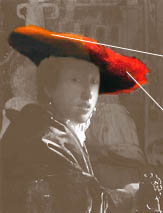
|
The wonderful
plumed hat was first modeled in vermilion using the most delicate sable brushes that
the artist probably fabricated by himself. Very little bone black was added in
the shaded area. While vermilion was the strongest red available to the
seventeenth-century artist, it tends to have a strong orange tone that was overcome by
glazing. Over the underpainting, two thin uniform glazes of madder lake were applied. This particular glaze was a very common practice among painters since the beginning of oil painting and was still used in Vermeer's times.
|
|
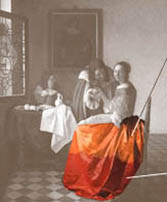
|
The lavish satin
dress was first underpainted in vermilion and flake white in the brighter areas. Very
little bone black was added in the shaded areas. The dress was painted in full final
detail at this stage. Corrections after the glaze were avoided as much as possible. When completely dry, the artist then applied one or two very thin glazes of madder lake. Two or more lighter glazes are easier to control than one thick one. |
|
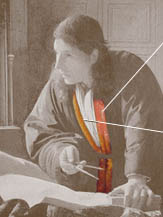
|
The borders
of the robe were first modeled in vermilion and flake white. Flake white is the
traditional name for lead white. The Dutch were particularly renowned for their high
quality flake white. Afterwards it was glazed with a yellow lake. This was the best way to produce a bright orange tone. The bright cadmium reds and oranges painters use today were invented two hundred years after Vermeer's time.
|
|
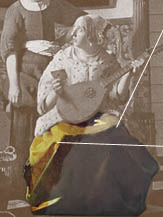
|
The
underpainting was given its definitive form using a warm monochrome rendering. Vermeer
probably added a littler bit of yellow ochre in the lighter parts. Yellow ochre is a dull
yellow earth pigment used often by painter because it has great covering power. He then glazed twice, or maybe even three times, since yellow lakes usually did not have a great tinctorial strength. Glazing tends to attract dust due to its high oil content. Care had to be taken to let the painting dry away from it. It is said that Frans van Mieries, a Dutch painter known for his incredibly detailed paintings, had his studio on a boat to avoid this problem.
|
|
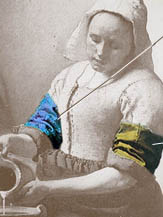
|
Vermeer seems to
have used this particular glaze quite often to create more luminous greens than could be
obtained by directly mixing yellow and blue. The sleeve was modeled with ultramarine blue
and flake white and then allowed to dry. A glaze of a yellow lake was applied with care. This technique is particularly evident in the zoomed image of the same painting in the Rijksmuseum web site.
|
|
|
< previous
next
> |
click here for books about the technique of Vermeer and the Great Masters |